 Leading Blog | Posts by Month |
 Leading Blog | Posts by Month |
04.30.23

LeadershipNow 140: April 2023 Compilation
See more on
Posted by Michael McKinney at 08:48 AM
04.28.23

Wonderhell: Why Success Doesn’t Feel Like It Should
SUCCESS is not a destination but a journey. And each achievement opens yet another door to our potential. The achievement feels wonderful, but just when we thought we reached to top, we feel the burden of the invitation to take another step into our newfound potential. We’re in what Laura Gassner Otting identifies as Wonderhell. Wonderhell is that place between who you are and who you are becoming. The wonderful excitement of who you are and the burden (hell) of the realization of who you can become. In Wonderhell: Why Success Doesn’t Feel Like It Should . . . and What to Do About It, Otting presents the ride of your life like entering an amusement park—Wonderhell. And every success invites us back to the entrance to take the ride again. Just when we thought we could rest on our past, we are invited into a future of new opportunities. We step into the Imaginarium, and we can see the new life we want to have. It’s bigger and bolder, and we enter Impostertown. Who am I to take this next step? Who do I think I am? Otting wisely points out that we are not who we think we are. We are not what others think we are. We are who we think others think we are. It’s time to deal with our inner voice. “Standing on the edge of our incompetence” makes us fearful and feel like an imposter. “You could run from this fear. You could hide from this future. You could lie to yourself about what you want. Many people do, swallowing that dream down into their belly, where it becomes a cancerous lament, festering away disguised as malaise, dissatisfaction, or worse, prudence.” In Impostertown we see the fortune teller and enter the Hall of Mirrors, the Tent of Oddities, and the Haunted House. We learn to make our own luck, let go of the things that hold us back, and turn our limitations into invitations. Stick to the facts. They are greater than our emotions. “The more we observe and absorb information about a potential change, the more we begin to understand how to make that change happen,” and make our own luck.
Once we’ve gotten rid of that internal voice in our head that limits us, we now enter Doubtsville. We face the uncertainty, the discomfort, and doubt about our new potential. It’s a rollercoaster of emotions. You will never be ready. Control what you can control and take the first step. Accountability motivates. Much of the fear and anxiety that comes from all of the external voices. In Doubstville, we learn to create boundaries over who we listen to. We turn up the volume on those who believe in us and turn down the volume on those who only see our faults and obstacles. “Got a family member who always worries you’re taking too big a risk? Share some details of your plan when you’ve already got it in place. Bear in mind: most of the people who are busy sharing opinions wouldn’t have the time to do so if they were just as busy as you, bringing their own goals to fruition.” Who do you need to have on your team? You’re on your way, but there’s one more dimension to the amusement park: Burnout City. “Wonderhell isn’t just a place you visit once. If you have a vision (and the stomach for going after it), you get to come back over and over again. Anticipate this repeat voyage—and even welcome it!—and you’ll live to tell the tale. But the key isn’t just to survive Wonderhell. Your goal is to thrive in it.” You might be tempted to hold on to where you’ve already been, but that will slowly steal your wonder and leave you with nothing but the hell. Understanding how the rides work reduces our stress and helps us to enjoy the ride. If we are in Wonderhell, we’re on the right track to live out our potential. If you have a dream, a plan, a demon, a potential, or an unshakable goal that excites you and scares you at the same time, Otting offers the Wonderhell Quiz to find a way through it. Where are you in Wonderhell? 
Posted by Michael McKinney at 12:00 PM
04.27.23

Leading Thoughts for April 27, 2023
IDEAS shared have the power to expand perspectives, change thinking, and move lives. Here are two ideas for the curious mind to engage with: INSEAD professor Manfred F. R. Kets de Vries on wisdom: “Wise people recognize that life moves with an ebb and a flow. There will be highs and lows and there will be peaks and valleys. Life is never going to be an easy ride, but during this journey that is your life there can be discovery, change and growth if that is what you seek. During this journey, you can have a choice: you can acquire wisdom or you can remain blinded. What you decide to do is all up to you. This journey towards wisdom very much implies living in the present, planning for the future, and profiting from the past.” Source: Leading Wisely: Becoming a Reflective Leader in Turbulent Times Adam Markel on what’s worth fighting for: “Part of keeping calm is just doing the thing that’s I front of you and not getting your emotions lost in fighting battles about what is fair or unfair. That’s a losing proposition. Even when we’re correct and we’re fighting over what is fair or unfair, we’re losing. There’s right and there’s wrong. That’s different. That’s worth fighting for.” Source: Change Proof: Leveraging the Power of Uncertainty to Build Long-term Resilience Look for these ideas every Thursday on the Leading Blog. Find more ideas on the LeadingThoughts index.
Posted by Michael McKinney at 07:41 AM
04.25.23

The Four Workarounds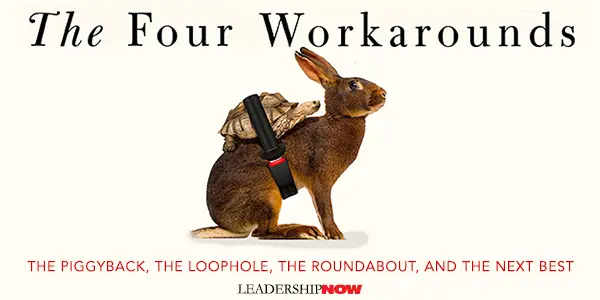
WORKAROUNDS are a deviation from the norm. They are nonconformity. Conformity isn’t all bad; we often do it without much thought. But there are times when we are better served when we ask why and perhaps deviate from the expected. Oxford University professor Paulo Savaget makes a distinction between disobedience and deviance in The Four Workarounds: Strategies from the World's Scrappiest Organizations for Tackling Complex Problems. He says that disobedience isn’t the opposite of conformity. “Disobedience blatantly antagonizes the establishment, and the establishment almost always retaliates in kind. Deviance, on the other hand, is trickier. Deviance entails unconventional approaches that use parts of the status quo that work (as intended or not) in order to change the parts that don’t.” Deviance is the opposite of conformity. Savaget identifies three approaches to deviance or standing out from the crowd. First, there’s confrontation which “always means clashes against dominant power structures.” Second, there’s negotiation to put pressure “on authority figures to legitimize changes in the system of rules.” And finally, there’s the workaround. “Through workarounds, we can promptly get things done and defy the status quo without directly antagonizing rule enforcers.” Workarounds are the lower-risk option for moving something along. There are four workarounds each using a different attribute. Knowing each approach can help you determine the best response to getting things done. The Piggyback “The piggyback workaround enables us to circumvent all sorts of obstacles and address our problems by using seemingly unrelated relationships.” The piggyback often creates relationships between unconventional partners. Piggybacks occur “between silos rather than in them.” A couple solved a problem of distributing life-saving medicines in Sub-Saharan Africa by piggybacking on the distribution of Coca-Cola that was readily available in the region. Oreo piggybacked clever Twitter advertising on the 2013 Super Bowl power outage. The Loophole “The loophole either capitalizes on an ambiguity or uses an unconventional set of rules when they aren’t the most obviously applicable.” In looking for loopholes, remember that “there’s often more than one way to be right, and simply following or breaking rules isn’t always the best way to get something done. Often there is an option that lies in between.” The Roundabout A roundabout may not solve the problem, but it can buy us time until we can find a permanent solution. It can be useful if you use that time wisely. “Roundabouts don’t so much tackle systemic challenges as interrupt self-reinforcing behaviors and but time to mobilize, negotiate, and develop alternatives, alleviating an urgent problem while building momentum to pivot in a different direction.” The Next Best Next-best workarounds use what is available to solve an immediate goal. “Using limited resources, scrappy organizations and mavericks teach us that often the best step forward is not focusing on what the ideal ought to be, but instead drawing attention to available opportunities that tend to be ignored.” A great example of a next-best workaround is the non-profit Rainforest Connection to thwart illegal logging. By repurposing old cell phones strategically placed in the rainforest to listen for the sound of chainsaws, they are able to send real-time alerts to rangers and community patrols with the location of the logging to catch loggers in the act. Each of the workarounds has a primary element at play. When you think about piggybacks, consider the existing relationships in your situation. Loopholes require paying close attention to different sets of rules. Roundabouts involve examining behaviors that lead to inertia. And if you’re searching for next-best approaches, fiddle with the resources you have on hand. Not every situation is going to necessitate using each of these four workarounds, and that’s okay. In the end, you really only need one workaround for most challenges. 
Posted by Michael McKinney at 07:20 PM
04.21.23

Winning the Relay Race of Family Wealth Transfer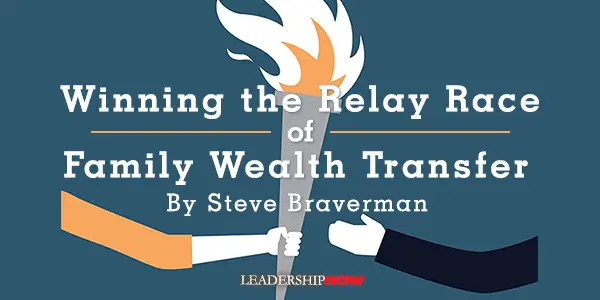
TOO MANY grantors feel that just preparing the documents for the passing on of the wealth — such as setting up a trust — is the end of the process. But it’s really just the beginning because their inheritors need to be prepared to deal with the wealth. Grantors need to share what they’ve learned about managing wealth. If they don’t, it’s like putting someone into a relay race with no coaching or training. They’ll be paralyzed, or they’ll stumble and fall, or they’ll be pushed off the track. The way I like to describe wealth management and transfer is that it’s like running a relay race. This metaphor captures the process and the spirit in which we need to take on that process. Looking at the relay race historically, the first runner is the one who initially created the family wealth. That may have happened some time ago in your family, or you may be that first runner. The baton represents the wealth itself. The other runners are the generations to whom that wealth will be passed. If you’ve ever watched relay races, you know that passing the baton is often the trickiest part. Many of them get dropped, making it impossible for the team to win the race. But even if the passing of the baton is smooth, each runner must know how to make the most of their strengths and be passionate about how to run the race in order to advance the baton as successfully as possible. When you or anyone else in your family is running their leg of the wealth race — working with the wealth they’ve inherited — they need to know their strengths and be passionate about how they’re using the opportunity that this wealth provides. In order to run a successful race, the teammates must help and support one another. The veteran runners must share their knowledge and provide support for the rookies. The rookies must be allowed to figure out what kind of approach to running their leg of the race will motivate and excite them and will keep them going when the running gets difficult. Usually, teams need a coach to help them make the most of their potential. It’s the same way with managing and passing on wealth — the experienced wealth managers in the family, and the coach, must educate the inexperienced members of the family. And they must allow those rookies to figure out how they can best employ the wealth being passed on to them, not dictate to them how to do that. So, that’s the overall metaphor for wealth management and transfer that I use, and now we’ll look at each aspect of the race more closely. When you’re handed the baton to run your leg, you are a steward of your family’s wealth management. You have the opportunity to use, develop, and hopefully increase that wealth. Just like a runner needs coaching and training to deal with the challenges that come up during a relay race — weather conditions, the state of the track, the behavior of opponents — you will require support and guidance to succeed at handling your inherited wealth, either from experienced people from within your family or from professional family advisor outside of it, or both. But, at the end of the day, it’s your responsibility — and your opportunity — to run that leg of the race in a way that’s personally fulfilling for you. At the same time, you should always keep in mind that the baton, your wealth, isn’t just yours; you’re part of a team — your family — and the baton will be passed on to others. So make the most of your time with that baton! By inheriting wealth, you’re given a lead in life, and you’re also given the opportunity to extend that lead for the next generation. How do you measure that lead? Dollars and cents? Impact on society? Successful perpetuation of the family legacy? It’s usually some of all of these things, but when you get to the end of running your leg of the race, you’re meant to transition to helping those who come after you to run the next leg successfully, to optimize their performance, to help them think through and adjust to any adverse conditions they might encounter. In the wealth management and transfer process, if someone drops the baton, gets nudged off the track, or gets tripped up, you can be there to support them — the way a veteran athlete helps a rookie — by saying things such as, “Look, you’re not using the best technique” or “Hey, I can show you how you lost your lead there” or “There are ways to ensure you don’t get nudged off track.” You can talk to them and help them along. (This is something the wealth management “coach” can do, too.) Veterans of dealing with wealth can share what they’ve experienced with the next generation, provide perspective, help them develop their own plan, and monitor their progress. You can share both the responsibility and the success. Because, in the end, what you’re all aiming for is to get the whole family to the top of the podium, shaking hands and celebrating their victory.  
Posted by Michael McKinney at 07:15 AM
04.20.23

Leading Thoughts for April 20, 2023
IDEAS shared have the power to expand perspectives, change thinking, and move lives. Here are two ideas for the curious mind to engage with: As the new CEO of United Airlines, Oscar Munoz on listening: “Perhaps it wasn’t as important that I proved to employees that I had all the answers to every problem. If I simply demonstrated that, before I intended to lead, I wanted to listen and learn from them, perhaps that would be enough to generate goodwill. Source: Turnaround Time: Uniting an Airline and Its Employees in the Friendly Skies Bertrand Russell on how to grow old: “Psychologically there are two dangers to be guarded against in old age. One of these is undue absorption in the past. It does not do to live in memories, in regrets for the good old days, or in sadness about friends who are dead. One’s thoughts must be directed to the future, and to things about which there is something to be done. This is not always easy; one’s own past is a gradually increasing weight. It is easy to think to oneself that one’s emotions used to be more vivid than they are, and one’s mind more keen. If this is true, it should be forgotten, and if it is forgotten it will probably not be true. Source: Portraits from Memory and Other Essays Look for these ideas every Thursday on the Leading Blog. Find more ideas on the LeadingThoughts index.
Posted by Michael McKinney at 07:38 AM
04.17.23

Grace Under Pressure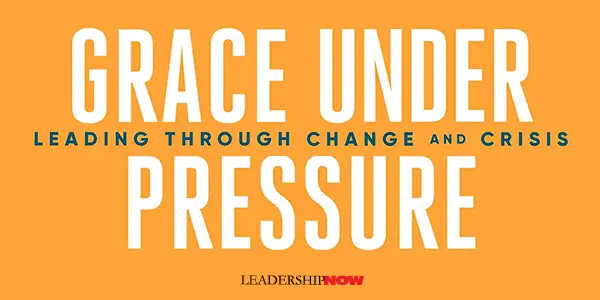
REMAINING clam in moments of urgency when things are coming apart at the seams is the subject of Grace Under Pressure: Leading Through Change and Crisis by John Baldoni. Good leaders do three things, writes Baldoni. One, they take care of their people. Two, they take care of themselves. And three, they prepare for the future. What pulls them all together is grace. Grace is the “catalyst for the greater good.” Grace is critical to creating a connection with others that leads to positive forward movement. “When it comes to dealing with change and crisis, grace becomes evident in how we treat one another.” Baldoni looks at the three characteristics of good leaders through the lens of grace. In all three areas, Baldoni stresses the importance of community. It’s good for the organization, it’s good for you, and it’s good moving forward into the future and whatever it may bring. “Communities by nature are places where people feel they belong.” But it’s more than that, says Baldoni. “It is more than a place to work; it becomes a place to be.” We seek to create community where individuals feel empowered to lead with conviction rooted in wisdom, compassion gained from suffering, and good examples learned from experience. Three lessons regarding community:
Grace makes this possible. “Grace facilitates our ability to connect with ourselves more genuinely so that we can contribute more humanly with others. Such connections are essential to keep oneself together when everything around seems to be falling apart.” Here are some thoughts in brief from each of the three sections on how to demonstrate grace under pressure: Good Leaders Take Care of Their People Build resilience through divergent thinking throughout your organization. Become a better listener. Be direct and honest but inspire hope in the face of uncertainty and crisis. How can I make things better for others? How can I find humor in the situation? Good Leaders Take Care of Themselves Anchor yourself on the values that are most important to you. Even in a changing world, they will not change. Prioritize what is most important. Be intentional. Confront your biases and be willing to change. Assume the best in others. Good Leaders Prepare for the Future A crisis often elicits innovation. It is important that we are open to it and encourage it by listening to others. Be patient. “Having patience gives us the space to learn and enables the heart to direct and our character to rise to the fore.” Baldoni advises, “Speed to the chase, but wait for the opportunity.” Grace is more than a thought. It is a practice. It is something we do. In the final section of the book, Baldoni presents pithy and practical chapters for practicing grace under pressure. He highlights the many and sometimes subtle mindsets that motivate grace into action. At the end of the book, Baldoni summarizes his thoughts in a handbook and challenges us with a Grace Under Pressure Self-Assessment. Grace Under Pressure means meeting: 
Posted by Michael McKinney at 01:42 PM
04.14.23

A Cure for the Common Company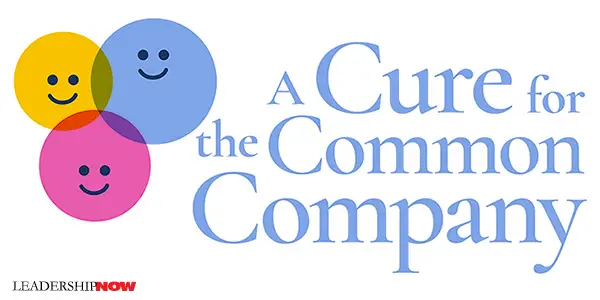
IT SHOULD go without saying that the health and well-being of employees have a direct impact on the success of an organization. Yet, it is unusual for an organization to put it on the high-priority list along with profitability and customer service. The solution is to build it into the culture of the organization. Willpower alone won’t do it. Chief Medical Director of Employee Health and Well-Being at John Hopkins Medicine, Richard Safeer, provides six building blocks to do that in A Cure for the Common Company. 1. Shared Values Including employees through conversation or, in most cases, online surveys is a good way to know the values are shared. “Don’t try to sweep discontent under the rug. As a manger or leader, if you interact with an employee who doesn’t care for the shared values of the organization, try to help them find their personal connection.” The challenge, of course, is getting a refined set of values and definition of well-being with the buy-in of dozens, hundreds, or thousands of employees, all of whom have their own values and cultures they bring to work with them every day. 2. Social Climate “Leaders can promote a positive social climate by building a sense of community, fostering positive attitudes, and creating a shared vision.” Questions to ask include, “What process does your organization have in place to help new employees feel like they are part of the team right away?” “What opportunities do you create for employees to socialize?” “What volunteering opportunities has the organization provided for your employees?” 3. Norms Norms are the way the organization does what it does—behaviors that we do without much thought. “In organizations around the world, norms that run counter to what is healthy for most people are rampant.” It’s not just free donuts but work hours, after-hour emails, and eating in front of your computer. “Norms can be identified, and they can be changed, and when we make the effort, we can have a profound positive impact on people, teams, and organizations.” Knowing the impact of soda on the health of the employees, Safeer began tackling that at John Hopkins: I took a stroll through our buildings. Sure enough, there was soda everywhere: the cafeteria, vending machines, gift shops. It was served at our meetings. Our culture embraced unhealthy beverages. The widespread presence of soda, along with visual cues, product placement, and financial incentive (at the time, a soda cost less than the same size bottle of water) were all contributing to a culture of unhealthy nutrition and making it easier for our workforce to accept that drinking soda was the norm. 4. Culture Connection Points A cultural connection point is where the design of the workplace acts upon our well-being. “Cultural connection point can influence healthy behaviors and attitude, or they can be complicit in unhealthy behaviors and attitudes.” Connection points like the green leaf symbol tagged to healthy foods, choices placed at eye-level, fitness classes, rewards and recognition all help to support healthy life choices. 5. Peer Support Willpower is not a good strategy. Peers can provide support and help to build subcultures that encourage healthy choices. “Peer support is unique in that it is based on a trusted relationship, is ongoing, and is grounded in a familiarity with day-to-day circumstances.” 6. Leadership Engagement Well-Being needs to be on the leadership agenda along with everything else like finance and customer service. Participate in well-being initiatives. “Well-being is not an expense, it is an investment, and without it, you’ll end up with ‘No People, No Profit.’” Leaders need to eliminate organizational speed-bumps. Safeer points out nine speed-bumps like all talk, no action, a lack of accountability, losing focus, and moving too fast. The building blocks are pretty straightforward, but part of the challenge is dealing with all of the various subcultures that exist within the organization. While you are trying to create a culture pointing in one direction, there may be subcultures that point its members in a completely different direction, like that group that smokes behind the building. Subcultures do not have to be solely formed around work-related elements. They can be formed around common interests of a group, such as jogging or sharing the same religious beliefs. 
Posted by Michael McKinney at 02:08 PM
04.13.23

Leading Thoughts for April 13, 2023
IDEAS shared have the power to expand perspectives, change thinking, and move lives. Here are two ideas for the curious mind to engage with: Laura Gassner Otting on just taking action: “When struggling to make big life choices—leaving a job, ending a relationship, seeking more education, quitting smoking—studies show people who flip a coin and ‘go for it’ regardless of the outcome are more satisfied with their decisions and much happier six months later than those whose coin toss instructed them to maintain the status quo. Action beats stagnation. When you’re unsure about what to do, you’ll be happiest if you just choose something to do.” Source: Wonderhell: Why Success Doesn't Feel Like It Should . . . and What to Do About It Admiral William H. McRaven on death before dishonor: “Leadership is difficult because it is a human interaction, and nothing is more daunting, more frustrating, more complex than trying to lead men and women in tough times. Source: The Wisdom of the Bullfrog: Leadership Made Simple (But Not Easy) Look for these ideas every Thursday on the Leading Blog. Find more ideas on the LeadingThoughts index.
Posted by Michael McKinney at 03:56 PM
04.07.23

Is Your Workplace Plagued by Disrespect? Take This Step to Disarm It
NAME-CALLING. Stereotyping. Micromanaging. Foul language. Is your workplace a hotbed of disrespect—and are productivity and collaboration tanking because of it? When co-workers, managers, and their subordinates lose respect for one another, it negatively impacts their work and the work of the people around them. Some organizations respond with well-meaning exhortations to “just get along,” or they encourage private chats with human resources or senior management. Yet quite often, there’s no action taken at all. If someone’s disrespectful behavior crosses a policy or legal line, there may be an investigation followed by disciplinary action, interventional coaching, a lateral transfer, demotion, or termination. Or—once again—there may be nothing done at all. Is there a better way to address and curb disrespect at work? Without a doubt, yes. At the Center for Respectful Leadership, we believe that Coaching for Respect™ (CfR) is something every organization should consider trying first (even if they rule it out) before moving to more formal, investigative, disciplinary, or legal remedies. At the core of this process is a simple question: What do you respect in the other person? We’ve found that when co-workers clash over disrespectful behavior or language, what they do respect in their colleagues isn’t completely obscured. It’s just being overridden by intense negative feelings and emotions. Once the “what happened”—the intentions, actions, impacts, and perceptions—are uncovered and explored through coaching and rational discussion, what people respect in each other is much easier to see. And their work environment will improve because of it. Three Common Areas of Respect Typically, what we respect in our work colleagues falls into three areas or attributes:
By having people identify precisely what they respect in others, they’ll start to break down hardened perceptions, such as an employee labeling a colleague as a “disrespectful person” or the accused suggesting the aggrieved party is “too sensitive” or “a complainer.” Ideally, you’re trying to get the sparring parties to identify something they respect that relates to their work together. For example, an aggrieved employee may respect a particular skill the accused has and understand that without it, their own work will be much harder, or impossible, to accomplish. Be warned: This can be a challenging process. Strong, negative feelings make some people resistant to seeing offenders in anything but a negative light. You’re going to have to work hard here and be persistent, respectfully, of course! Ask for Specifics Ask the parties to specifically name the traits and attributes they respect in each other. What events, times, and places have showcased these traits in the past? Don’t accept “There’s nothing I respect in them” as a final answer because if you do, you won’t be able to move forward with the process. Here are some approaches and opening lines you might use:
The bottom line: We don’t have to like a person to work with them, but we do have to have a level of respect for them. Without respect between co-workers, it’s almost impossible to work effectively and productively. Next Steps Identifying respected traits and attributes is just one step of Coaching for Respect.™ If you have colleagues who have fallen out with each other due to perceived disrespectful behaviors—and if you have the willingness, the positional authority, and the patience to try something supportive and collaborative first—the CfR process may be exactly what’s needed to turn that relationship around.  
Posted by Michael McKinney at 09:12 AM
04.06.23

Leading Thoughts for April 6, 2023
IDEAS shared have the power to expand perspectives, change thinking, and move lives. Here are two ideas for the curious mind to engage with: Dave Ramsey on momentum: “Momentum is an interesting and somewhat elusive thing. When you have momentum in any area of your life you look better than you are. When your star is shining everyone thinks you are smarter and prettier than you really are. Conversely when you don’t have momentum you are better than you look. What we discovered is that momentum is not a random lightning strike, but on the contrary, it is actually created.” Source: EntreLeadership: 20 Years of Practical Business Wisdom from the Trenches Associate professor Mark de Rond on lovable fools and competent jerks: “The analysis suggests that if someone is strongly disliked, it is almost irrelevant whether or not he is competent. By contrast, if someone is liked, her colleagues will seek out every bit of competence she has to offer, meaning that a little likeability has far more mileage than competence in making someone a desirable team player.” Source: There Is an I in Team: What Elite Athletes and Coaches Really Know About High Performance Look for these ideas every Thursday on the Leading Blog. Find more ideas on the LeadingThoughts index.
Posted by Michael McKinney at 06:35 AM
04.01.23

First Look: Leadership Books for April 2023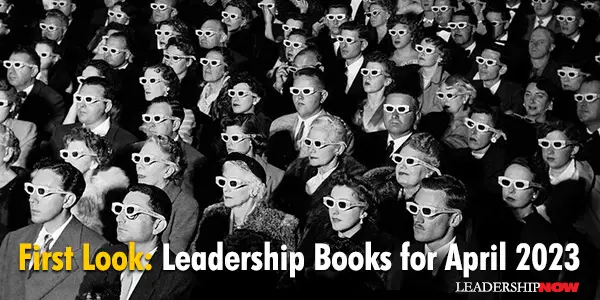
HERE'S A LOOK at some of the best leadership books to be released in April 2023 curated just for you. Be sure to check out the other great titles being offered this month.
The title “Bullfrog” is given to the Navy SEAL who has served the longest on active duty. Admiral McRaven was honored to receive this honor in 2011 when he took charge of the United States Special Operations Command. When McRaven retired in 2014, he had 37 years as a Navy SEAL under his belt, leading men and women at every level of the special operations community. During those four decades, Admiral McRaven dealt with every conceivable leadership challenge, from commanding combat operations—including the capture of Saddam Hussein, the rescue of Captain Phillips, and the raid for Osama bin Laden. THE WISDOM OF THE BULLFROG draws on these and countless other experiences from Admiral McRaven’s incredible life, including crisis situations, management debates, organizational transitions, and ethical dilemmas, to provide readers with the most important leadership lessons he has learned over the course of his forty years of service.
Grace Under Pressure: Leading Through Change and Crisis focuses on three things leaders need to do when change and adversity strike: take care of their people, take care of themselves, and prepare for the future. And they must do it all with a sense of grace—calmly, collectedly, and compassionately. He shares his expertise here, focusing on how leaders need to prepare for change by focusing on what matters most—their people. Among the themes Baldoni explores are fear and loss as well as empathy, resilience, and hope. This book also provides a roadmap for leaders seeking to create community as they meet the coming challenges with dignity and grace.
From the preeminent presidential scholar and acclaimed biographer of historical figures including George Washington, Herbert Hoover, and Nelson Rockefeller comes this eye-opening life of Gerald R. Ford, whose presidency arguably set the course for post-liberal America and a post-Cold War world. For many Americans, President Gerald Ford was the genial accident of history who controversially pardoned his Watergate-tarnished predecessor, presided over the fall of Saigon, and became a punching bag on Saturday Night Live. Yet as Richard Norton Smith reveals in a book full of surprises, Ford was an underrated leader whose tough decisions and personal decency look better with the passage of time.
Anxiety disorders are the most common mental illnesses in the world. But in our workplaces, anxiety has been a hidden problem—there in plain sight but ignored. Until now. The Anxious Achiever is a book with a mission: to normalize anxiety and leadership. As leadership expert and self-proclaimed anxious achiever Morra Aarons-Mele argues, anxiety is built into the very nature of leadership. It can—and should—be harnessed into a force for good. Inspired by the popular podcast of the same name, The Anxious Achiever is filled with personal stories, research-based insights into mental health, and lots of practical advice.
We say some people march to the beat of a different drummer. But implicit in this cliché is that the rest of us march to the same beat. We sleepwalk through life, find ourselves on well-worn paths that were never ours to walk, and become a silent extra in someone else’s story. Extraordinary people carve their own paths as leaders and creators. They think and act with genuine independence. They stand out from the crowd because they embody their own shape and color. We call these people geniuses—as if they’re another breed. But genius isn’t for a special few. It can be cultivated. This book will show you how. You’ll learn how to discard what no longer serves you and discover your first principles—the qualities that make up your genius. You’ll be equipped to escape your intellectual prisons and generate original insights from your own depths. You’ll discover how to look where others don’t look and see what others don’t see.
There's a force we encounter every day that we aren't aware of—and it threatens to derail otherwise promising careers and lives: microstress. This hidden epidemic of small moments of stress has insidiously infiltrated both our work and our personal lives with invisible but devastating effects. Microstress doesn't trigger the normal stress response in our brains to help us deal with it. Instead, it embeds itself in our minds and accumulates daily, one microstress on top of the other. Unregistered microstress weighs us down, damages our physical and emotional health, and contributes to a decline in our well-being. What's more, microstress is baked into our lives. The source is seldom a classic antagonist, such as a demanding client or a jerk boss. Instead, it comes from the people with whom we are closest: our friends, family, and colleagues. The good news is that once you understand microstress, you can fight back.
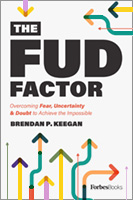 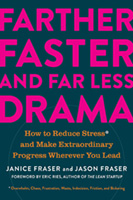 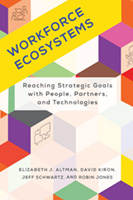 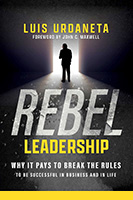
“... a mind needs books as a sword needs a whetstone, if it is to keep its edge.” — George R.R. Martin, A Game of Thrones
Posted by Michael McKinney at 07:40 AM
|
BUILD YOUR KNOWLEDGE


How to Do Your Start-Up Right STRAIGHT TALK FOR START-UPS 
Grow Your Leadership Skills NEW AND UPCOMING LEADERSHIP BOOKS 
Leadership Minute BITE-SIZE CONCEPTS YOU CAN CHEW ON 
Classic Leadership Books BOOKS TO READ BEFORE YOU LEAD |
|